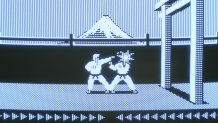In the corner of a crowded convention hall filled with the latest game-building technology, Louis Castle happened upon an old Apple II with a black-and-white monitor, running a game off a floppy disk.
The game was Karateka — an early martial arts game, published years before the arcade hit Street Fighter II took fighting games mainstream. And it reminded Castle of a story.
"They actually did a lot of rotoscoping," he explained. "They took films and drew over the top of film cells to get the motion of the characters."
Situated amid booths where actors and dancers performed eye-catching stunts for digital motion capture cameras, here was one of the games that pioneered the technique 40 years ago using film and paper.

"Back when I started in the industry, when the Game Developers Conference started, everybody had to be a programmer for the most part," he explained. "My first games, I used to draw on graph paper, and then bubble it in and convert it to hexadecimal, and type it in. There were no mice, no tablets, nothing like that."
Castle estimates he's created some 150 games over the four decades of his career. Some were big hits, like Blade Runner. Others were built just for fun, or published as printed source code in early game developer magazines. But over the years, most of those early games fell through the cracks of time and were lost. In an industry focused squarely on the future, it turns out that's an incredibly common story.

"We found that many games have been lost — from even 15 years ago," said Stephenie Hawkins, event director for the annual Game Developers Conference — of which Castle sits on the advisory board.
Get a weekly recap of the latest San Francisco Bay Area housing news. Sign up for NBC Bay Area’s Housing Deconstructed newsletter.
Hawkins said conference organizers have partnered for years with the Oakland-based Museum of Art and Digital Entertainment, bringing exhibits to the convention halls like the one in which Karateka was on display. But in 2024, game preservation took center stage as a major theme of the conference — and Hawkins said there's a growing sentiment that it should become a bigger priority for the industry.
The first name in classic games
A renewed focus on preserving classic games is music to the ears of 36-year-old Wade Rosen. Arriving outside a hotel conference room carrying a backpack and sporting a vintage Atari T-shirt, he hardly looks like the chief executive of a company founded in the 1970s. And that's exactly the point.
"I always joke we're a 50-year-old startup," Rosen said.
In 2021, he took over as CEO of Atari — perhaps the most storied name in the the video game industry's short history. Founded in the Bay Area, Atari launched its cartridge-based Video Computer System in 1977, bringing games like Asteroids and Pac-Man to living rooms all over the world.
Though later eclipsed by newer consoles from the likes of Nintendo and Sega, Atari's legacy shines brightly among the childhood memories of Gen X, and Rosen wants to lean into that.
"To really say, hey, let's focus on retro, classic gaming, and be the best in the world at that," he said.
Back in the early days, games didn't need to have stories or characters. It was a simpler time, when consoles ran at speeds slower than 1 megahertz, and had only a few kilobytes of memory (sometimes less). Still, developers managed to craft experiences that were fun, challenging and addictive.
"You don't really need to know why you're shooting the bugs," Rosen said, in a reference to the 1981 Atari classic game Centipede. "You're just jumping in and shooting bugs, and it's fun!"
A sequel long overdue
Atari's history is filled with firsts, including Lunar Lander — the first arcade game to use vector-based graphics. Now, 45 years later, Atari thinks the popular black-and-white game from 1979 deserves a sequel.
"This is Lunar Lander Beyond," Rosen explained, while playing through a demo of the new game on a PC (and crashing his spacecraft several times in the process).

The new game has a character-driven storyline and colorful graphics, and Atari is releasing it on just about every modern console, including PlayStation, XBOX and Nintendo Switch. There are sequels to other classic games in the works too. But Atari has something else up its sleeve.
"We just kept hearing from people, 'Hey, I've got all these old Atari carts. What can I do with them?'"
New Atari, who dis?
In late 2023, Atari announced the answer: the Atari 2600+.
Though not the company's first retro console, the $130 Atari 2600+ is certainly its most ambitious. It's a meticulously-crafted 80% scale model of Atari's first home console, complete with wood-grain front panel and old 9-pin controller ports. It comes with a joystick that's nearly indistinguishable from the original model released in the 1970s, and a cartridge loaded with 10 classic Atari games.

Aside from the smaller size and light-up Atari logo, the new console has another important change: an HDMI port to connect to modern TVs. Rosen says Atari is serious about preserving the games from its glory days, and that means building a console that can work in today's living rooms. But equally important, he said, is preserving the vintage experience: this is still a cartridge-based console, which means if you want to play a game, you'll have to go out and find it in cartridge form.
"What we're finding is a community of people who want that physicality, that want to be able to touch and really experience it the way they did growing up," he said. "And so that's who we're trying to appeal to."
In the months since its release, Atari has fleshed out the 2600+ lineup with a set of paddles — the knob-like controllers used for playing games like Breakout and Pong — and even a brand new game coded for the 2600 called Mr. Run and Jump. With its release, what started out as a developer's side project became the first brand new Atari game to be released in cartridge form since 1991. And just like the old days, it was hand-coded in assembly language (and might have involved some drawings on graph paper).
Humans vs. robots
Long before advanced graphical tools existed for game development, Castle says the best tool was — and still is — the human imagination.
"There's just so many great ideas in old games," he said. "In fact, almost every new game that comes out that's super exciting has an old game that actually kind of inspired it."
Castle's faith in human creativity is so strong, in fact, that he's not worried about the rapid evolution of generative artificial intelligence. Quite the contrary, he says: he welcomes it.
"Our industry's in a bit of a crisis, because the cost of developing content has become so high," he said. "What's nice about the (generative) AI's is they can actually leverage the talent we already have to create more things more quickly."

Already, at this year's Game Developers Conference, independent studios showed off games that featured AI-created and AI-assisted game artwork. Kipwak Studios spent just 8 months building its first playable version of Wizdom Academy — a game in which players manage a Hogwarts-like school for young wizards.
"For the art, it's AI-assisted," explained lead developer Guillaume Mezino. "What we do is we sketch first ... Then we take that sketch and we give it to an AI, so that it can produce something better. (Then) we take back the art, we polish it, and we do that kind of cooperative work until we are satisfied with the product."
Castle says he's optimistic this sort of human-AI cooperation won't cost game designers their jobs. In an industry bursting with creativity, original ideas are still the most valuable currency of all.
"People imagine in their mind's eye what they want to see," he said. "I think that's what drives innovation, is imagining what could be, rather than just basing things on what has been."
Some ideas will be good, and some will be great — and every once in awhile, an idea will become a classic.
"Are people going to be playing Super Mario World in 100 years?" Rosen asked rhetorically. "Absolutely. They're going to go back and play that in the same way that we read Gatsby today. It is still going to be relevant."



